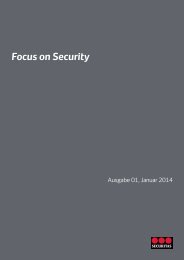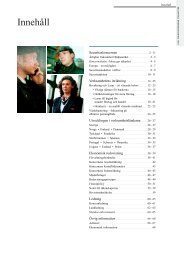SECURITAS AB Annual Report 2011
SECURITAS AB Annual Report 2011
SECURITAS AB Annual Report 2011
Create successful ePaper yourself
Turn your PDF publications into a flip-book with our unique Google optimized e-Paper software.
86 <strong>Annual</strong> <strong>Report</strong><br />
Notes and comments to the consolidated financial statements<br />
Note 4. Critical estimates and judgments<br />
The preparation of financial reports requires the Board of Directors and Group<br />
Management to make estimates and judgments using certain assumptions.<br />
Estimates and judgments will impact both the statement of income and the<br />
balance sheet as well as disclosures such as contingent liabilities. Actual<br />
results may differ from these estimates and judgments under different<br />
assumptions and conditions.<br />
Acquisition of subsidiaries / operations and contingent<br />
considerations including acquisition related option liabilities<br />
The valuation of identifiable assets and liabilities in connection with the<br />
acquisition of subsidiaries or operations involves that items in the acquired<br />
company’s balance sheet as well as items that have not been recognized in<br />
the acquired company’s balance sheet such as customer relations should<br />
be valued at fair value. In normal circumstances, as quoted market prices are<br />
not available for the assets and liabilities that are to be valued, different<br />
valuation methods have to be used. These valuation methods are based on<br />
a number of assumptions. For a personnel intensive company like Securitas,<br />
employee related items such as accrued salaries, accrued social benefits,<br />
holiday pay, long-term employee benefits and post-employment benefits<br />
are significant items in the balance sheet that can be difficult to value.<br />
Accounts receivable is another example of a significant balance sheet item<br />
where it can be difficult to value the amount of bad debt and thus to what<br />
extent they will be collected. Other items that can be difficult both to identify<br />
as well as to value are contingent liabilities that could have arisen in the<br />
acquired company in connection with for example litigations. The valuation<br />
of identifiable assets and liabilities is also dependent on the accounting environment<br />
that the acquired company/operations has been active in. This is<br />
true for example for the basis of preparation for the financial reporting and<br />
consequently the extent of adjustments that are necessary in order to<br />
follow the Group’s accounting principles, the frequency for which closings<br />
have been prepared and the availability of different types of data that can be<br />
necessary in order to value identifiable assets and liabilities. All balance<br />
sheet items are thus subject to estimates and judgments. This also means<br />
that the initial accounting may have to be provisionally determined and<br />
subsequently adjusted. All acquisition calculations are finalized no later than<br />
one year after the acquisition is made. Considering the above description,<br />
Securitas has chosen not to state the reasons to why the initial accounting<br />
of the business combination is provisional nor which assets and liabilities<br />
for which the initial accounting is provisional for each individual business<br />
combination unless it is a material adjustment.<br />
All payments to acquire a subsidiary/operation are recorded at fair value<br />
at the acquisition date, including debt related to contingent considerations<br />
and acquisition related option liabilities (deferred considerations). This debt<br />
is measured at fair value in subsequent periods with re-measurement<br />
through the statement of income. The final outcome of deferred considerations<br />
often depends on one or more events which only will be confirmed<br />
by a future development such as the future profitability development for an<br />
agreed period. The final outcome can therefore either be lower or higher<br />
than the initially recognized amount. Deferred considerations, which<br />
amount to MSEK 606.1 (297.5 and 294.1), are thus subject to critical<br />
estimates and judgments.<br />
further information regarding acquisitions is provided in note 16 and<br />
regarding revaluation of deferred considerations in note 11.<br />
Impairment testing of goodwill, other acquisition related<br />
intangible assets and shares in associated companies<br />
In connection with the impairment testing of goodwill, other acquisition<br />
related intangible assets and shares in associated companies, the book<br />
value is compared with the recoverable value. The recoverable value is<br />
determined by the higher of an asset’s net realizable value and its value in<br />
use. Since under normal circumstances no quoted market prices are available<br />
to assess an asset’s net realizable value, the book value is normally com-<br />
Securitas <strong>Annual</strong> <strong>Report</strong> <strong>2011</strong><br />
pared with the value in use. The calculation of the value in use is based on<br />
assumptions and judgments. The most important assumptions are the<br />
organic sales growth, the development of the operating margin, the operating<br />
working capital requirements and the relevant WACC, which is used to discount<br />
future cash flows. All in all, this means that the valuation of the balance sheet<br />
items goodwill, which amounts to MSEK 14 727.4 (13 338.8 and 13 558.3),<br />
acquisition related intangible assets, which amounts to MSEK 1 574.1<br />
(1 096.5 and 894.9) and shares in associated companies, which amounts<br />
to MSEK 108.2 (125.6 and 132.1) are subject to critical estimates and<br />
judgments. A sensitivity analysis regarding the organic sales growth, the<br />
operating margin and the WACC is provided in note 16.<br />
Valuation of accounts receivable<br />
and the provision for bad debt losses<br />
Accounts receivable, which amounts to MSEK 10 965.0 (9 724.1 and<br />
9 363.3), is one of the most significant balance sheet items. Accounts receivable<br />
are accounted for at nominal value net after provisions for probable bad<br />
debt. The provision for bad debt losses, which amounts to MSEK -419.3<br />
(-344.7 and -377.9), is thus subject to critical estimates and judgments.<br />
As stated above accounts receivable is often an important item in relation to<br />
the acquisition of subsidiaries/operations. Further information regarding the<br />
credit risk in accounts receivable is provided in note 6. Information regarding<br />
the development of the provision for bad debt losses during the year is<br />
provided in note 25.<br />
Actuarial calculations regarding employee benefits<br />
such as pensions and medical benefits<br />
Employee benefits are normally an area where estimates and judgments are<br />
not critical. However, for defined benefit plans relating to benefits particularly<br />
for pensions and medical benefits and where the payment to the employee<br />
is several years into the future, actuarial calculations are required. These<br />
calculations are based on assumptions regarding economic variables such<br />
as the discount rate, the expected return on plan assets, salary increases,<br />
inflation rate, pension increases and the inflation rate for medical benefits,<br />
but also on demographic variables such as the expected life span. All in all,<br />
the balance sheet item pension balances for defined benefit plans, which<br />
amounts to MSEK 0.0 (0.0 and 36.2) and which is stated under other longterm<br />
receivables (note 23), and the balance sheet item provisions for pensions<br />
and similar commitments, which amounts to MSEK 1 453.5 (1 151.2<br />
and 1 186.3), are subject to critical estimates and judgments. The Group’s<br />
opinion is that the most important assumptions are the discount rate, the<br />
inflation rate and the expected life span. A sensitivity analysis regarding<br />
these three variables is provided in note 31.<br />
Actuarial calculations regarding claims reserves<br />
and timing of outflows<br />
The Group is exposed to various types of risks in the day-to-day running of the<br />
business. The operational risks can result in the need to recognize reserves for<br />
damages resulting from property claims, personal injuries as well as workers’<br />
compensation claims relating to the Group’s employees. Claims reserves are<br />
calculated based on a combination of case reserves and incurred but not<br />
reported reserves. Actuarial calculations are performed on a quarterly basis to<br />
assess the adequacy of the reserves based on open claims and historical data<br />
for incurred but not reported claims. Actuarial calculations are based on several<br />
assumptions. Claims reserves comprise a large number of individual insurance<br />
cases where some cases are compensated with a lump-sum payment and<br />
others are paid over a longer period of time. It is thus not possible to disclose<br />
any detailed information regarding the timing of outflows from claims reserves.<br />
All in all, this means that the balance sheet items short-term liability<br />
insurance-related claims reserves, which amounts to MSEK 662.8 (526.2<br />
and 503.6) and is included in short-term provisions (note 35) and liability<br />
insurance-related claims reserves, which amounts to MSEK 410.5 (461.3<br />
and 526.5) and is included in other long-term provisions (note 32), are<br />
subject to critical estimates and judgments.

















